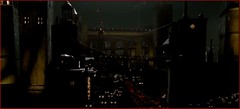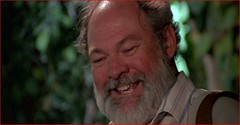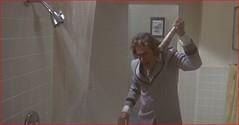Note: Heavy spoilers herein.
I watch Point Blank a lot. It's probably in the top 3 for my most-played DVDs. Most of this is due to how intoxicating the opening 20 minutes of the movie are, with director John Boorman taking the viewer on a manic spree of exposition both confusing and exhilarating. In these 20 minutes there are haunting moments that will never be equaled through the remainder of Point Blank: Walker's "awakening" in his cell, his march through LAX, the frozen shots and eerie jazz notes of the opening credits, Walker's initial meeting with Yost (Keenan Wynn), and most of all -- the time Walker (Lee Marvin) spends in the house of his ex-wife Lynne (Sharon Acker). It's these opening scenes that embed Point Blank in film history, where it removes itself from all other tough guy movies and becomes something else. And it's after these scenes when the movie becomes fairly straightforward, with chronological narration and few questions about what's going on. It's not until the final scene on Alcatraz (the final minute, really) that Point Blank comes back to where it began.
Point Blank is a movie about supernatural rebirth through vengeance. Through what means it is thankfully never explained, but it also cannot be argued that Walker is not human. His new self lies somewhere between ghost and an urban zombie born out of concrete and steel, nearly incapable of emotion but always ready to put his inhuman durability to work. We see Walker's "awakening" before the violent act that landed him in the cell, his body twitches as if a current had just shot through it. Slowly, he recalls why he is lying in a cold jail cell: Walker was shot three times at point blank range by his double-crossing friend Reese, who walked off with Walker's share of the loot as well as his wife.
The amount of time that passes between the shooting and Walker's resurrection is never explained, though it seems to be at least a few months since Reese has had time to rise up the Organization's ladder. After miraculously swimming from Alcatraz back to San Francisco, Walker returns to the island on a tour boat, cleaned up and dressed in a suit. On the boat Walker meets his spiritual partner, Yost, who acts as if he expected Walker to be there, and informs the recently-resurrected of a plan to get his money back and take down the Organization as well. Walker listens to Yost as if he's being fed a command, and when he hears that Reese is living with Lynne, he silently launches himself toward Los Angeles, fueled by supernatural revenge.
What follows is the best scene in Point Blank, starting with Walker's iconic march through LAX -- the sound of his hammering feet will follow us all the way to Lynne's door -- and ending with the house being drained of all life. When Walker bursts through Lynne's door and tosses her aside, he heads for the bedroom and empties his revolver into the master bed before he even realizes there's no Reese in it. This shot is later replayed in slow motion in Walker's head, and it's easy to read it as a sexual manifestation of his revenge, his bullets burning holes in the very spot where Walker spent countless nights with his wife.
If Walker is powered by paranormal revenge, then it was expended on the aforementioned bed. After the shots are fired, Walker sulks onto Lynne's couch, not bothering to look at his ex-wife as she recounts a memory of happier times -- herself nearly a lifeless ghost. Walker seems to fade in and out of consciousness, recalling the previous days events, and then finding a dead Lynne on the bed with an empty jar of pills nearby. It's unclear exactly what happens after Lynne's death, but I see it as Walker recharging his energy for a spree of daring moves that will eventually take him back to Alcatraz. He fades in and out again, watches Lynne's spilled bottles of perfume flow down the drain (an allusion to her soul draining away, Boorman explains in the commentary track), and wakes up to an empty house with someone knocking on the door. How long was he in there? What happened to Lynne's belongings? The man at the door proves that Lynne indeed lived there, so you can't say the scene with her was a dream. Did her belongings represent her soul -- and does it now power Walker?
The newly-harnessed energy helps Walker rip through the Organization, and takes him back to Alcatraz where his money awaits. But the money never finds its way into Walker's hands, rather he slowly fades back into his eternal steel confines. It's a perfect ending, enhanced by the fact that Boorman never attempts to explain what was behind Walker's resurrection, or exactly what transpired in Lynne's apartment. There's also the question of Yost, was he responsible for Walker waking up again in the cell, and does that mean Yost is of the same existence as the new Walker? Damn, I gotta watch this again.
Wednesday, July 16, 2008
Waking up the echoes
Filed Under Essays
Subscribe to:
Post Comments (Atom)















5 comments:
Great post Adam.
I love this movie as well, but could never quite figure it out.
But I agree that it is best left unsaid. My favorite shot in the picture is towards the beginning, when Walker is escaping. He's kneeling over a grate and the light from below casts shadow bars over his face.
To me, at least in that shot, he looks like a vengeful ghost.
Plus, his grey suit is super cool.
Thanks Joseph, I know that shot, very cool.
And good call on "Blas of Silence," I picked it up last week and am glad I did. Great movie.
Nicely crafted piece on Point Blank, Adam. A surreal gangster flick! Perhaps Yost represents some part of Walker's unconscious dreaming up a revenge scenario? I haven't seen this yet, but after reading this post I feel the need to get out and see it asap.
I enjoyed reading your thoughts about Point Blank, Adam!
I love the ambiguity of the film. That quality is so often missing from modern movies. So many directors tend to spell out EVERYTHING for their audience. Foreshadowing has also become somewhat of a lost art.
The ending isn't actually on Alcatraz, but in the old Fort Point on the shore by the foot of the Golden Gate Bridge (as Carroll O'Connor's character says, "The location's different but the drop is the same.") Which is why and how we get the tilt up in the last shot to look out from the shore off to Alcatraz in the distance, where it all started (or, if you're among those who think the whole film has happened in Walker's head as he's dying in the cell after being shot by Reese, where it's all been anyway).
It's fun to compare POINT BLANK to Lester's similarly-fragmented PETULIA, which also has scenes on the Alcatraz boat and in Fort Point, shot right around the same time.
The exterior of the building used for the final sequence is also the structure right next to where "Madeline Elster" jumps in the bay in VERTIGO.
http://www.nps.gov/fopo/index.htm
Post a Comment